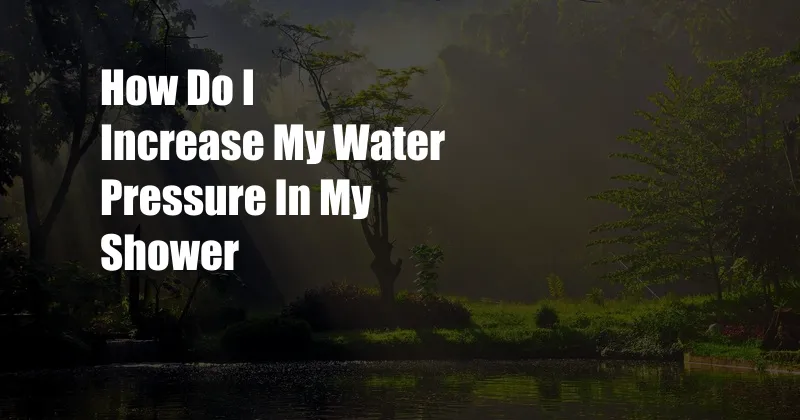
How Do I Increase My Water Pressure in My Shower?
Have you ever stepped into a shower expecting a refreshing and invigorating experience, only to be met with a pitiful trickle of water? Low water pressure in your shower can be an incredibly frustrating experience, robbing you of that much-needed🚿🚿🚿 post-workout rinse or a relaxing evening shower. But fear not! With a few simple steps, you can bid farewell to wimpy water pressure and enjoy a glorious deluge in your shower once again.
Before we delve into the how-to’s, let’s shed some light on the culprit behind low water pressure. The most common reasons include clogged showerheads, faulty pressure-reducing valves, and plumbing issues. Understanding the cause will help you target the right solution and restore your shower to its former glory.
Identifying the Culprit: Troubleshooting Low Water Pressure
To pinpoint the cause of low water pressure in your shower, start with the simplest and most accessible solution: the showerhead. Over time, mineral deposits and debris can accumulate in the showerhead’s tiny nozzles, obstructing the flow of water. Simply remove the showerhead and soak it in a solution of vinegar and water for a few hours. Rinse thoroughly, reinstall the showerhead, and cross your fingers — you might just have solved the problem.
If the showerhead is not the culprit, the next step is to check the pressure-reducing valve (PRV). This valve, typically located near the water meter or where the main water line enters your home, regulates incoming water pressure to prevent damage to household plumbing fixtures. A faulty PRV can restrict water flow, resulting in low shower pressure. To adjust the PRV, locate the adjustment screw and turn it counterclockwise to increase water pressure. It’s important to note that excessive water pressure can be harmful to plumbing fixtures, so make small adjustments and test the water pressure before going overboard.
Professional Plumbing Solutions for Persistent Pressure Problems
If cleaning the showerhead and adjusting the PRV fail to resolve the issue, you may be dealing with a more complex plumbing problem. This could include leaks in the pipes, faulty valves, or even a clogged main water line. In such cases, it’s best to call in a licensed plumber to diagnose and fix the problem. They have the necessary tools and expertise to identify the root cause and restore your water pressure to optimal levels.
Additional Tips and Expert Advice for Enhanced Shower Pressure
In addition to the troubleshooting steps mentioned above, here are a few expert tips to help you increase water pressure in your shower:
- Check for leaks: Even small leaks in the plumbing system can affect water pressure. Inspect all pipes, faucets, and appliances for any signs of water seepage and address them promptly.
- Consider a shower pump: If you have chronically low water pressure in your entire home, installing a shower pump can provide a significant boost. Consult a plumber for professional advice on choosing and installing the right pump for your needs.
- Upgrade your showerhead: Some showerheads are designed to optimize water flow and pressure. Look for showerheads with a high flow rate and wide spray patterns to maximize your shower experience.
Frequently Asked Questions (FAQs) about Shower Water Pressure
- Q: Can low water pressure damage my showerhead?
A: Yes, low water pressure can cause the showerhead to work harder to compensate, leading to premature wear and tear. - Q: How often should I clean my showerhead?
A: It’s recommended to clean your showerhead every few months to prevent mineral buildup and maintain optimal water pressure. - Q: What is the ideal water pressure for a shower?
A: The ideal water pressure for a shower is between 40 and 60 pounds per square inch (psi).
Conclusion: Shower Power at Your Fingertips
Remember, low water pressure in your shower doesn’t have to be a permanent problem. By following the steps outlined above, you can identify the cause and restore your shower to its full potential. Whether it’s a simple showerhead cleaning or a more complex plumbing issue, don’t hesitate to seek professional help if needed. With a little effort, you can turn your shower into an oasis of relaxation and rejuvenation, starting with that perfect blast of water pressure.
Are you ready to experience the ultimate shower experience? Share your thoughts and questions in the comments below!